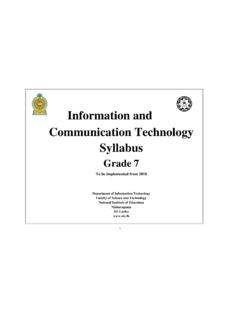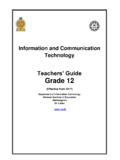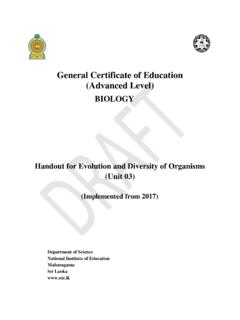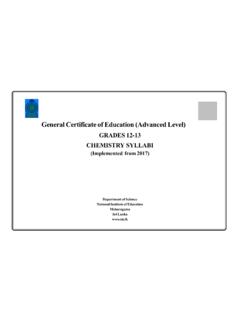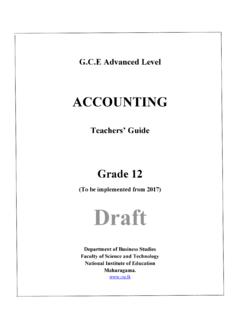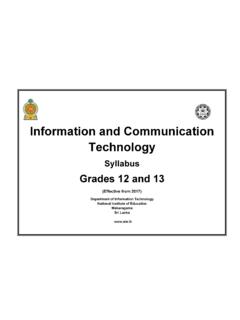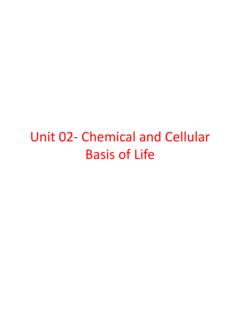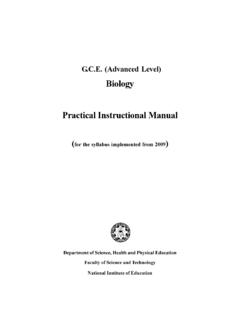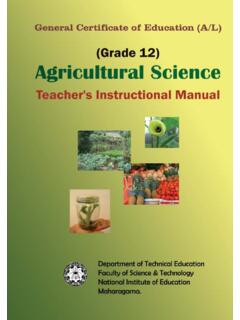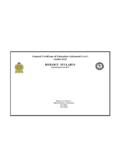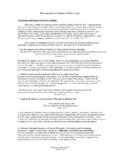Transcription of G. C. E. (Advanced Level) CHEMISTRY Grade 12
1 I G. C. E. (Advanced Level) CHEMISTRY Grade 12 Unit 1: Atomic Structure Unit 2: Structure and Bonding Unit 3: Chemical Calculations Department of Science Faculty of Science and Technology National Institute of Education ii CHEMISTRY Resource Book Grade 12 National Institute of Education First Print 2018 Department of Science Faculty of Science and Technology National Institute of Education Sri Lanka Published by: Press National Institute of Education Maharagama Sri Lanka iii Message from the Director General The National Institute of Education takes opportune steps from time to time for the development of quality in education.
2 Preparation of supplementary resource books for respective subjects is one such initiative. Supplementary resource books have been composed by a team of curriculum developers of the National Institute of Education, subject experts from the national universities and experienced teachers from the school system. Because these resource books have been written so that they are in line with the G. C. E. (A/L) new syllabus implemented in 2017, students can broaden their understanding of the subject matter by referring these books while teachers can refer them in order to plan more effective learning teaching activities. I wish to express my sincere gratitude to the staff members of the National Institute of Education and external subject experts who made their academic contribution to make this material available to you.
3 Dr. (Mrs.) T. A. R. J. Gunasekara Director General National Institute of Education Maharagama. iv Message from the Director Since 2017, a rationalized curriculum, which is an updated version of the previous curriculum is in effect for the (A/L) in the general education system of Sri Lanka. In this new curriculum cycle, revisions were made in the subject content, mode of delivery and curricular materials of the (A/L) Physics, CHEMISTRY and Biology. Several alterations in the learning teaching sequence were also made. A new Teachers Guide was introduced in place of the previous Teacher s Instruction Manual. In concurrence to that, certain changes in the learning teaching methodology, evaluation and assessment are expected.
4 The newly introduced Teachers Guide provides learning outcomes, a guideline for teachers to mould the learning events, assessment and evaluation. When implementing the previous curricula, the use of internationally recognized standard textbooks published in English was imperative for the Advanced Level science subjects. Due to the contradictions of facts related to the subject matter between different textbooks and inclusion of the content beyond the limits of the local curriculum, the usage of those books was not convenient for both teachers and students. This book comes to you as an attempt to overcome that issue. As this book is available in Sinhala, Tamil, and English, the book offers students an opportunity to refer the relevant subject content in their mother tongue as well as in English within the limits of the local curriculum.
5 It also provides both students and teachers a source of reliable information expected by the curriculum instead of various information gathered from the other sources. This book authored by subject experts from the universities and experienced subject teachers is presented to you followed by the approval of the Academic Affairs Board and the Council of the National Institute of Education. Thus, it can be recommended as a material of high standard. Dr. A. D. A. De Silva Director Department of Science v Guidance Dr. (Mrs.) T. A. R. J. Gunasekara Director General National Institute of Education Supervision Dr. A. D. A. De Silva Director, Department of Science National Institute of Education Mr.
6 R. S. J. P. Uduporuwa Former Director, Department of Science National Institute of Education Subject Leader Mrs. M. S. Wickramasinghe Assistant Lecturer, Department of Science National Institute of Education Internal Editorial Panel Mr. L. K. Waduge Senior Lecturer, Department of Science Mrs. G. G. P. S. Perera Assistant Lecturer, Department of Science Mr. V. Rajudevan Assistant Lecturer, Department of Science Writing Panel Dr. Russel C. L. de Silva - Senior Lecturer, Department of CHEMISTRY , University of Kelaniya (Unit 1) Dr. Prasantha - Senior Lecturer, Department of CHEMISTRY , University of Sri Jayewardenepura (Unit 2) Dr.
7 Kaumal - Senior Lecturer, Department of CHEMISTRY , University of Colombo (Unit 3) External Editorial Panel Prof. S. P. Deraniyagala - Senior Professor, Department of CHEMISTRY , University of Sri Jayewardenepura Prof. M. D. P. De Costa - Senior Professor, Department of CHEMISTRY , University of Colombo Prof. H. M. D. N. Priyantha - Senior Professor, Department of CHEMISTRY , University of Peradeniya Prof. Sudantha Liyanage - Dean, Faculty of Applied Sciences, University of Sri Jayewardenepura Mr. K. D. Bandula Kumara - Deputy Commissioner, Education Publication Department, Ministry of Education Mrs. Deepika Nethsinghe - SLTS-1 (Rtd), Ladies College, Colombo 07 vi Mrs.
8 Muditha Athukorala - SLTS-1, Prajapathi Balika Vidyalaya, Horana Miss. C. A. N. Perera - SLTS-1, Princess of Wales , Moratuwa Mrs. V. K. W. D. Salika Madavi - SLTS-1, Muslim Ladies College, Colombo 04 Mrs. D. Manike - SLTS-1, Viharamhadevi Balika Vidyalaya, Kiribathgoda Mr. S. Thillainathan - SLTS-1 (Rtd), Hindu Ladies College, Colombo 06 Miss. S. Veluppillai - SLTS-1 (Rtd), Hindu Ladies College, Colombo 06 Mrs. M. Thirunavukarasu - SLTS-1 (Rtd), Hindu Ladies College, Colombo 06 Mrs. S. Rajadurai - SLTS-1 (Rtd), St. Peters' College, Colombo 04 Language Editing Dr. Chandra Amarasekara Consultant, National Institute of Education Mr. M. A. P. Munasinghe Chief Project Officer (Rtd.), National Institute of Education Cover Page Mrs.
9 R. R. K. Pathirana Technical Assitant, National Institute of Education Supporting Staff Weerawardana Mr. Mangala Welipitiya Mr. Ranjith Dayawansa vii Content Message from the Director General .. iii Message from the Director .. iv Subject v Atomic The atomic theory of Properties of cathode rays (Experimental observations) The nucleus of the atom Properties of positive rays (Experimental observations) Rutherford s gold foil experiment Atomic number, isotopes and mass number The atomic mass scale Average atomic mass and relative atomic mass of an element Ions Electromagnetic radiation and wave-like properties of Quantization of energy Electronic energy levels of The hydrogen spectrum Shapes of orbitals Orbitals and quantum numbers Electron configuration.
10 23 Aufbau principle The Pauli exclusion principle Hund's rule Condensed electron configurations Building of periodic table ..28 Periodic trends shown by s and p block elements ..32 Sizes of atoms and ions Ionization energy Electron gain energy Electronegativity Structure and Covalent Lewis dot diagrams and Lewis dot dash structures Dative covalent Valance Shell Electron Pair Repulsion theory (VSEPR theory) ..52 Hybridization of atomic orbitals Formation of double and triple bonds Resonance structures Effect of electronegativity and geometry on the polarity of molecules Dipole moment Factors affecting the magnitude of electronegativity Ionic bonds/ ionic interactions.
